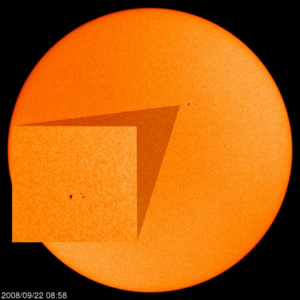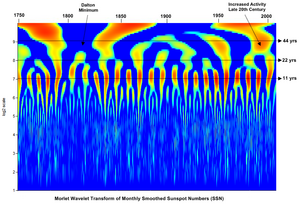
|
| ©NASA |
In other news, Jan Jansens reports that SC23-24 continues to behave much more like cycles in the late 19th and early 20th century. See this.
Also, courtesy Basil, a new way to look at sunspot numbers. This is a Morlet wavelet transform of smoothed sunspot numbers (SSN).

|
| ©Unknown |
Time is read along the horizontal axis, and a time scale is drawn across the top of the image. Frequency is read on the verticle axis. The scale is 2**x months, where is is 1,2,3..9. So 2**7 is 128 months. I've drawn lines at approximately 11 yrs, 22 yrs, and 44 yrs. Amplitude is indicated by color. The basic 11 year Schwabe cycle is clearly indicated by the red ovals bisected by the line for 11 years. I've noted the Dalton Minimum, which is clearly different in character than the other cycles - with weaker and longer solar cycles. It is subtle, but you can see the weaker intensity of solar cycles 10-15 compared to solar cycles 16-23 in the weaker color of the earlier cycles. There is clearly enhanced activity, and of longer duration, at the end of the 20th century.
There is also a weaker, but distinct, level of activity at 22 years, the double sunspot of Hale cycle. The last three Hale cycles have been stronger than earlier Hale cycles. There is some indication of a double Hale cycle (~44 years) and at the top of the graph, we're in Gleissberg cycle territory.
Now, for an interesting observation and speculation, note that at present, which is at the right edge of the chart, from the 11 yr line to the top it is all blue. There is only one other place on the entire chart where we can draw a vertical line from the 11 yr line to the top without it crossing some portion of color other than blue. Can you find it? (It is right at the beginning of Solar Cycle 5, i.e. the Dalton Minimum). Are we watching the beginning of a new 200 year cycle like what began with the Dalton Minimum in the early 1800's? Obviously, no one knows. But the current transition is certainly unusual, and invites comparison to past transitions.



Reader Comments
to our Newsletter